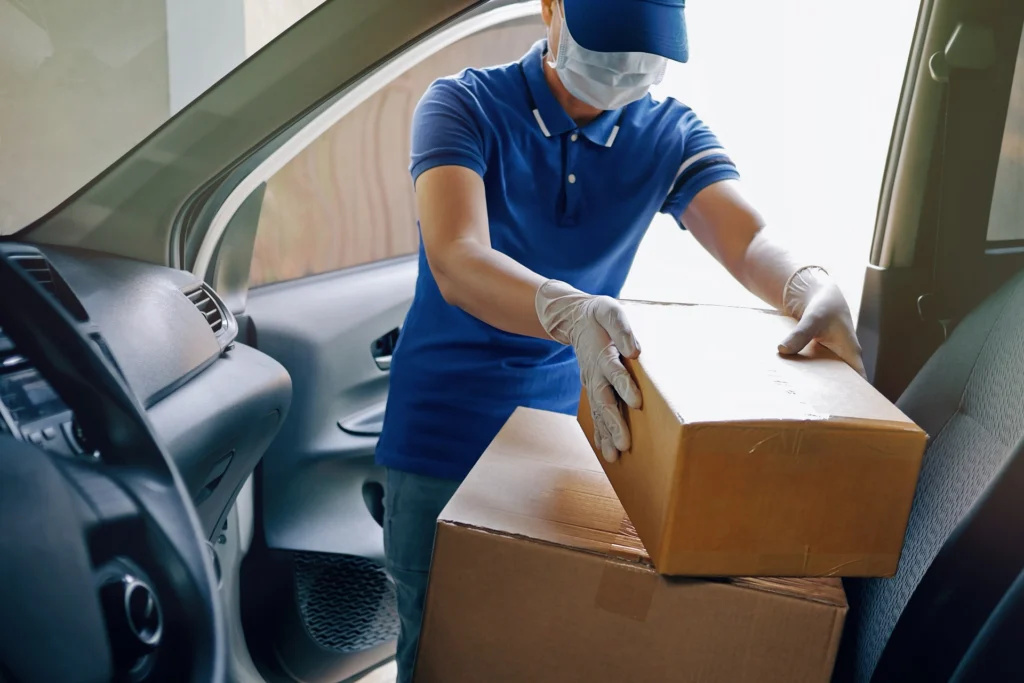32 eCommerce & Logistics Experts Reveal the Most Significant Ways eCommerce Growth Has Impacted Last-Mile Logistics

Wise Systems

It’s no secret that e-commerce has had a dramatic impact on retail shopping since its outset. During the COVID-19 pandemic, e-commerce was a lifeline, enabling consumers to purchase essentials without entering a brick-and-mortar location, making it possible to maintain appropriate social distancing.
Along with this massive growth came increased pressure on logistics companies—those responsible for transporting the goods from their point of origin to the end consumer. The effects of e-commerce growth are particularly impactful in last-mile logistics, which faces unique challenges such as increased complexity, inefficiency, and high costs.
We reached out to a panel of e-commerce and logistics industry experts to delve deeper into the impacts of e-commerce growth on last-mile logistics.
In this article:
- A Brief History of eCommerce
- Meet Our Panel of eCommerce and Logistics Experts
- The Most Significant Ways eCommerce Growth Has Impacted Last-Mile Logistics
- Frequently Asked Questions
A Brief History of eCommerce

The advent of the World Wide Web in 1991 made the internet more accessible to the general public. In a way, it made the world smaller by making it easier for people to communicate no matter their geographic distance.
In just a few short years, the emergence of e-commerce companies—such as Amazon in 1994 and eBay in 1995—sparked a significant transformation in the way people shop. Other advances aided this transformation, such as the introduction of SSL encryption in 1995, which ensured safe financial transactions.
In the early 2000s, the internet economy expanded rapidly and then crashed. In the midst of the dot-com bubble, however, e-commerce continued to grow.
Later in the 2000s, smartphones were introduced, making it possible to conduct transactions via their mobile devices, known as m-commerce.
In the 2010s, social media platforms like Facebook and Instagram began to integrate shopping capabilities, known as social commerce, further driving the growth of e-commerce.
Technology advancements continue to refine the online shopping experience. For instance, many e-commerce retailers now leverage artificial intelligence (AI) to create personalized shopping experiences and augmented reality (AR) to allow shoppers to visualize products in their own environments.
The COVID-19 pandemic in 2020 accelerated the adoption of e-commerce as lockdowns and social distancing measures made online shopping a necessity for many.
All of these factors have contributed to the steady, and sometimes explosive, growth of e-commerce. According to Boston Consulting Group, e-commerce is expected to account for 41% of global retail sales by 2027, an increase from 18% in 2017.
However, the online shopping transaction is just part of the equation. The logistics industry has had to adapt and keep pace with e-commerce growth. Without logistics, all the goods purchased online never make their way to consumers’ doorsteps.
Request a demo today to discover how the Wise Systems delivery automation platform can help your organization streamline last-mile logistics.
The massive growth of e-commerce has had a significant impact on the logistics industry, particularly the last mile. To explore the most significant impacts of e-commerce growth on last-mile delivery, we reached out to a panel of e-commerce and logistics experts and asked them to answer this question:
“What are the most significant ways eCommerce growth has impacted last-mile logistics?”
Meet Our Panel of eCommerce and Logistics Experts:
The Most Significant Ways eCommerce Growth Has Impacted Last-Mile Logistics
Keep reading to learn about the most significant ways e-commerce growth has impacted last-mile logistics.
 Vladimir Terekhov
Vladimir Terekhov
Vladimir Terekhov is the CEO of Attract Group, a company specializing in software development and business process optimization. We’ve worked extensively with e-commerce retailers, helping to streamline their operations and adapt to the evolving demands of last-mile delivery.
“The e-commerce boom has significantly impacted last-mile logistics in a few key ways…”
- Increased Demand for Speed: Consumers now expect rapid delivery, often within the same day. This has led to a need for more efficient routing and delivery scheduling systems.
- Greater Volume, Greater Complexity: With more orders, last-mile delivery has become more complex. Logistics companies must now manage a higher volume of smaller, more frequent deliveries.
- Technology Integration: To cope with the first two points, there’s been a surge in the adoption of advanced technologies. Real-time tracking, route optimization software, and automated dispatch systems have become essential.
- Sustainability Pressures: The rise in deliveries has put a spotlight on the environmental impact. Companies are exploring electric vehicles, optimized routes, and packaging to reduce their carbon footprint.
- Localized Distribution Centers: There’s a trend towards decentralized distribution, with localized centers closer to customers to facilitate quicker delivery times.
- Customer Experience Focus: Last-mile delivery is now a key differentiator in customer experience. Retailers are investing in technology to provide transparency and communication throughout the delivery process.
 Virginia Miller
Virginia Miller
Virginia Miller is a Spokesperson for Simple Fulfillment, an Austin-based leader in eCommerce fulfillment and FBA Prep.
“The surge in e-commerce has created undeniable ripples in the sphere of last-mile logistics…”
With e-commerce sales projected to reach $4.9 trillion globally by 2021, the heightened demand for efficient, swift and, most importantly, reliable deliveries is unprecedented.
This surge has precipitated a significant shift in operational strategies within last-mile delivery. To keep pace, services have had to streamline procedures, deploy advanced routing technology, and envision innovative delivery options like drone deliveries and smart lockers. Case in point, at Simple Fulfillment, we’ve witnessed first-hand how vital it has become to provide varied delivery options and real-time tracking to enhance customer satisfaction and repeat business in this e-commerce boom.
Looking forward, coping with e-commerce growth requires intelligent logistics solutions, and I believe the future lies in advancing last-mile technologies and personalized customer experiences. Whether AI-powered route optimization for quicker deliveries or sustainable packaging that addresses environmental concerns, last-mile logistics must continuously evolve to meet changing consumer preferences.
Learn how Wise Systems can streamline your last-mile logistics operations. Request a demo today.
 David Cohen
David Cohen
David Cohen is the CEO of Flower Station, one of the UK’s largest online flower delivery services, with several central London shops open 24/7.
“eCommerce growth has profoundly reshaped last-mile logistics, influencing how Flower Station operates…”
The demand for quick and flexible deliveries has surged, compelling us to optimize routes and adopt innovative technologies. Automation, such as route planning algorithms and autonomous vehicles, streamlines efficiency. Warehousing strategies have evolved to strategically position inventory closer to customers.
Additionally, heightened customer expectations necessitate robust communication and tracking systems. Flower Station continuously invests in these areas, ensuring our last-mile logistics align with the transformative impact of e-commerce growth, providing customers with swift, reliable, and transparent delivery experiences.
 Ethan Keller
Ethan Keller
Ethan Keller is the President of Dominion. Dominion is an international network of legal and financial advisors. We service high and ultra-high net worth clients looking to secure their assets and achieve financial peace of mind.
“eCommerce businesses are providing clients with more flexible delivery options, such as the ability to select certain delivery windows or even real-time tracking…”
This flexibility allows for the satisfaction of a wide range of client preferences and improves the overall experience for the customer.
Even though the expansion of e-commerce has led to an increase in the need for last-mile logistics, it has also presented difficulties in terms of the cost-effectiveness of delivery. The cost of each delivery can be rather expensive, and companies that provide logistics services are always looking for ways to minimize costs and maximize efficiency in their routes.
Customer expectations for the entirety of the delivery experience have increased as a result of the growth of e-commerce. These days, customers anticipate receiving precise tracking information, quick updates, and uninterrupted communication throughout the entirety of the last-mile delivery process.
 Andrew Griffith
Andrew Griffith
Andrew Griffith is the founder of Garden Furniture, a family business for over 25 years selling houseplants, gifts, homewares, and garden furniture to local customers and serving throughout the UK.
“eCommerce growth has profoundly reshaped last-mile logistics by driving investments in urban warehousing and micro-fulfillment centers…”
Recognizing the imperative for faster deliveries, e-commerce companies and logistics providers strategically position these smaller facilities in urban areas. By doing so, they substantially reduce transportation distances and enhance last-mile efficiency.
Urban warehouses and micro-fulfillment centers are pivotal innovations, streamlining the fulfillment process and enabling quicker order processing. This strategic response to increased demand exemplifies a paradigm shift in logistics, aligning with the accelerated pace of e-commerce.
These localized hubs represent a transformative solution, optimizing logistics networks and ensuring timely deliveries to meet the evolving expectations of consumers in the dynamic e-commerce landscape.
 Sergey Dvorkin
Sergey Dvorkin
Currently serving as the President of Flex Moving and Transport in Montreal, Sergey Dvorkin oversees the operations of this rapidly growing full-service moving company. In this capacity, he has developed a keen ability to harmonize customer-centric approaches with the creation of streamlined processes, ultimately resulting in cost reductions.
“Consumers are accustomed to having instant access to all the information they require or desire…”
Clients now want to track their products and view the estimated time of delivery. However, what if your clients could view the specific location of their delivery at all times?
Better yet, what if your clients could monitor the environmental circumstances in which their product is being delivered?
Consider time-sensitive goods like food or medicine. They can be tracked by smart technology such as RFID tags and GPS. adding sensors to your packages to keep an eye on things like pressure, temperature, humidity, and gas levels.
This degree of openness and visibility gives customers what they want, which increases their level of happiness. Additionally, shippers and retailers can access these sensors to better track their shipments in terms of weather patterns, delivery routes, and last-mile delivery efficiency.
Another way e-commerce growth has impacted last-mile logistics is adaptive routing. Regardless of the number of items on their trucks or the recipients of the packages, legacy shippers have set routes that their drivers must follow every day.
Package aggregation enables last-mile logistics firms to build denser delivery routes—more items delivered in fewer vehicles—and to dynamically modify those routes in response to demand.
Routes that are dynamically generated can cut hundreds of kilometers of waste. In the end, inefficiencies that cost needless miles, drivers, and fuel are mitigated by partnering with tech-forward providers who can fill transport cars from the sortation center, plan the most effective route, and change on-the-go route planning depending on new orders.
Book a demo today to learn how Wise Systems makes route optimization simple.
 Elisa Bender
Elisa Bender
Elisa Bender is the co-founder of RevenueGeeks.
“eCommerce growth has transformed last-mile logistics by increasing the volume of individual deliveries…”
With more people shopping online, delivery companies face the challenge of handling numerous small packages going to different addresses.
This shift demands more intricate route planning and efficient delivery systems. Companies now focus on technologies to streamline routes and optimize delivery schedules. It ensures prompt and cost-effective delivery to meet the rising demand for online shopping.
This impacts last-mile logistics significantly, pushing companies to adapt and innovate in order to handle the increased workload efficiently.
 Andrew Johnson
Andrew Johnson
Andrew Johnson is a Harvard-educated digital strategist with expertise in online promotions, trend forecasting, and consumer behavior analysis. Andrew merged all of these interests into one platform, Giveaways.org.
“Last-mile logistics has become more intricate and demanding…”
The surge in e-commerce has profoundly reshaped last-mile logistics, posing both challenges and innovations. With the increasing demand for quick deliveries, last-mile logistics have become more intricate and demanding.
Delivery speed expectations have accelerated, necessitating efficient route planning and optimized operations.
The rise of same-day and next-day deliveries has prompted innovations like automated delivery vehicles and drones.
On the downside, this growth has intensified traffic congestion and environmental concerns. Balancing speed, cost-effectiveness, and sustainability remains a pivotal challenge for last-mile logistics in the evolving landscape of e-commerce.
 Robert Khachatryan
Robert Khachatryan
Robert Khachatryan is the CEO and founder of Freight Right Global Logistics. He has expertise in ocean freight visibility, supply chain design, e-commerce shipping, freight marketplaces, and booking automation. With a background in rates and supply chain dynamics, he offers insights into current industry trends and challenges.
“The explosive growth of e-commerce in recent years has fundamentally reshaped last-mile logistics…”
- Increased Demand for Faster Delivery: eCommerce has led to a drastic increase in consumer demand for quicker delivery times, pushing logistics companies to optimize for same-day or next-day delivery. (45% of consumers anticipate a delivery window of up to 2 days.)
- Enhanced Tracking and Transparency: Customers increasingly expect real-time tracking and full transparency in the delivery process, a trend driven by e-commerce platforms.
- Diversification of Delivery Options: The growth of e-commerce has led to a wider range of delivery options, including the use of lockers, local pick-up points, and innovations in contactless delivery.
- Rise in Urban Warehousing: To meet rapid delivery demands, there’s been around 30% growth in urban warehousing and micro-fulfillment centers to reduce last-mile delivery distances.
- Sustainable Delivery Solutions: There’s a rising consumer demand for environmentally friendly delivery options, prompting last-mile logistics to adopt more sustainable practices. (The green logistics market is expected to demonstrate a CAGR of 6.1% by the year 2028.)
E-commerce growth has significantly influenced last-mile logistics, emphasizing speed, transparency, delivery diversity, urban fulfillment solutions, and sustainability. These changes are shaping the future direction of the industry.
 Connor Butterworth
Connor Butterworth
Connor Butterworth is the CEO & Owner of Southwestern Rugs Depot. Hailing from Athens, GA, Connor is a seasoned entrepreneur with a decade of experience in e-commerce. A multifaceted professional, he excels in filmmaking, web design, and digital marketing.
“The boom in e-commerce has indeed profoundly impacted last-mile logistics…”
The demand for rapid delivery has surged, ushering in a new era of expectations for same-day or next-day delivery. The massive increase in parcel volume has put immense pressure on delivery infrastructure, leading to the development of dynamic routing strategies that optimize delivery sequences in real time.
Customer experience has also emerged as a key differentiation factor. Delivery status updates and options to reschedule or reroute packages reflect that firms are investing heavily in delivering customer-centric experiences.
This has translated into the integration of advanced technologies like GPS tracking, machine learning, and AI into last-mile logistics.
Sustainability has also taken center stage. The growth of e-commerce and the increasing multitude of delivery vehicles have brought about serious environmental concerns. In response, companies are not only optimizing their routes to reduce carbon emissions but are also piloting eco-friendly delivery modes.
There’s likewise an upswing in the use of local warehouses. To meet the need for speed and convenience, businesses are turning to micro-fulfillment centers and leveraging localized inventories to reduce delivery time and cost.
 Robert Power
Robert Power
With a career spanning over 20 years, corporate and large business expert Robert Power is a seasoned professional with profound expertise in the realm of freight forwarding and logistics. As the Owner and Operational Director of Power Forwarding, he steers the company’s vision and operations with a blend of experience and innovation.
“eCommerce growth has dramatically increased the volume of last-mile deliveries…”
With more people shopping online, there are simply a lot more packages to be delivered, often to residential addresses rather than just commercial pickup points and this has put strain on logistics networks.
Getting items the ‘last mile’ to someone’s home is often more complex than business deliveries as it often requires more stops, residential navigation, customer contact, and a failed first attempt at delivery.
Customers have also come to expect faster shipping times and near-instant gratification. This requires logistics providers to optimize routes and offer same-day or next-day delivery options.
Beyond just speed, customers expect perfect orders, real-time tracking information, and a seamless post-purchase experience. Meeting these expectations is a challenge and has impacted the logistics of last-mile delivery.
With increased e-commerce volumes comes more returned packages that then need to be brought back into the logistics flow. Managing reverse logistics adds another layer of complexity to last-mile logistics.
eCommerce growth has also had a big impact on infrastructure. More home deliveries means more trucks and vans on residential roads, often during off-peak daytime hours.
To reduce extra traffic, logistics providers have adopted new technologies to meet the challenges of last-mile delivery in the e-commerce era. From smart package lockers to drones, there are going to be more advances in technology in the coming years to help with last-mile logistics.
Faster shipping and a better customer experience are within reach with Wise Systems. Schedule a demo today to learn how.
 Diana Zheng
Diana Zheng
Diana Zheng, Head of Marketing at Stallion Express, is a results-driven professional with diverse fitness, hospitality, and education backgrounds. With a proven track record in revenue generation and relationship building, she has successfully led two personal training businesses.
“One of the most significant implications is the need for faster and more efficient delivery services…”
Customers today anticipate speedier delivery times, requiring businesses to adapt and optimize their procedures.
Furthermore, the growth of e-commerce has increased the quantity of parcels being transported, particularly for cross-border transactions. This has put enormous strain on the current last-mile infrastructure, necessitating investments in advanced technologies such as route optimization software and automated warehouses to handle the additional volume efficiently.
Furthermore, as e-commerce has grown, there is a greater demand for more flexible delivery choices, such as same-day or time-specific deliveries, because customers desire ease and control over when and where their items are delivered.
Finally, the rise of online marketplaces like Amazon has altered customer expectations for free shipping and easy returns. This has caused businesses to rethink their logistics strategy and focus on reducing costs while providing good customer service.
To summarize, the e-commerce boom has transformed the last-mile logistics industry, resulting in faster delivery expectations, increasing package quantities, the need for flexible delivery alternatives, and a focus on cost minimization while maintaining customer happiness. As head of marketing at Stallion Express, I’ve been at the forefront of these changes, collaborating closely with our team to fulfill our clients’ changing expectations in the dynamic e-commerce sector.
 Benzo Lee
Benzo Lee
Benzo Lee is the co-founder of Autoboxup, deeply immersed in the manufacturing sector with a significant focus on how our operations interlink with supply chain and last-mile delivery logistics.
“eCommerce growth has impacted last-mile logistics in several ways…”
Handling Increased Volume and Demand:
The e-commerce boom has led to a remarkable increase in delivery volumes, with figures showing a jump from 20 million to 50 million packages delivered daily over the last five years. This surge has created an unprecedented demand for last-mile logistics services, pushing companies to scale operations, often resulting in increased operational costs ranging from 30% to 60%.
Meeting Expectations for Faster Delivery:
Consumer demand for quicker delivery has skyrocketed. Where 3-5 day delivery was once standard, most now expect 24-hour service. This shift necessitates last-mile logistics to evolve, often involving an investment increase of 25% to 50% in expedited delivery systems and workforce expansion.
Embracing Technological Advancements:
E-commerce growth has been a catalyst for innovation, leading to the adoption of cutting-edge technologies. For instance, investments in advanced tracking systems and route optimization software have grown by approximately 40% in the last three years. Moreover, exploratory investments in drones and autonomous vehicles are also on the rise, though they currently represent a smaller portion of overall logistics spend.
Addressing Urban Logistics Challenges:
The rise in urban delivery challenges, like traffic congestion and limited parking, has compelled logistics providers to invest in creative solutions. Implementing micro-fulfillment centers and urban warehousing strategies can increase logistics costs by 20% to 35%, but these solutions significantly enhance delivery efficiency in densely populated areas.
Prioritizing Sustainability:
The environmental impact of increased deliveries has shifted focus to sustainability. Investment in electric delivery vehicles and sustainable packaging solutions has escalated, with companies spending an estimated 15% to 30% more to implement these greener practices.
The landscape of last-mile logistics is rapidly evolving, driven by e-commerce growth. This evolution is marked by increased efficiency, a stronger integration of technology, and a heightened commitment to sustainable practices.
 Esther Strauss
Esther Strauss
Esther is the Co-Founder of Step by Step Business.
“Urban logistics innovation is a key response to the rise of e-commerce, especially in big cities…”
As more people shop online, delivering packages in crowded areas has become a big challenge. Think of traffic congestion, limited parking, and strict emission regulations.
To solve this, companies are trying new ideas. They’re setting up micro-fulfillment centers or small warehouses right in the city for quicker deliveries.
Additionally, alternative delivery modes, such as electric cargo bikes and drones, are increasingly used to navigate urban landscapes more effectively and reduce carbon emissions.
Plus, urban logistics also leverages advanced technology like AI and data analytics for optimizing routes and delivery times.
 Priyanka Swamy
Priyanka Swamy
Priyanka is the CEO and Founder of Perfect Locks Hair Company, a prominent brand in human hair extensions with over 16 years in the industry. Her creative experience with an architectural background has helped her create solutions for helping women look good and feel better. This ultimately led to building a market-leading brand in the hair extension industry.
“eCommerce growth has had a substantial impact on last-mile logistics in various ways…”
- Increased Demand: E-commerce’s growth has resulted in a 25% increase in consumer eCommerce delivery by 2020. This spike in demand has pushed logistics firms to improve their last-mile delivery capabilities.
- Consumer Expectations: Customers increasingly expect greater dependability and efficiency, including same-day deliveries and real-time package tracking. To meet these expectations, last-mile logistics has evolved.
- Environmental Impact: As consumers become more environmentally conscious, there has been a shift toward greener delivery methods. This includes increased use of electric vehicles and stronger carbon emissions regulations.
- Technological Innovations: eCommerce has fueled technological advances in last-mile logistics. Predictive analytics and courier management capabilities have emerged as important trends.
- Cost Implications: eCommerce items are often tiny in size, making last-mile delivery the most expensive aspect of the delivery process.
To summarize, the growth of e-commerce has transformed last-mile logistics, presenting new difficulties and opportunities for logistics providers. As an e-commerce retailer, you must adapt to these developments to ensure consumer pleasure and business success.
Request a demo to learn how to leverage the latest technological advancements in last-mile logistics with the Wise Systems delivery automation platform.
 Cort Adair
Cort Adair
Cort Adair is the CEO and owner of The Adair Group, an e-commerce wholesale clothing business.
“The growth of e-commerce has brought about substantial changes in last-mile logistics…”
One of the most significant impacts is the increased demand for faster and more flexible delivery options. Customers now expect same-day or next-day delivery, which has necessitated delivery route optimization and the use of technology to improve efficiency.
Lastly, e-commerce growth has led to the rise of alternative delivery methods, such as crowd-sourced delivery and lockers, to meet the evolving needs of consumers. These innovations aim to reduce the strain on traditional carriers while providing convenience to customers.
 Harrison Jordan
Harrison Jordan
Harrison Jordan is a Managing Lawyer of Substance Law.
“Organizations are coming to the conclusion that…”
Within this day and age of increased awareness of environmental issues, they must begin to implement environmentally friendly delivery solutions.
Electric and hybrid vehicles, as well as the utilization of green energy sources for logistics operations, are all included in this category.
The packaging industry is likewise seeing a shift, with an emphasis on minimizing environmental effects and reducing waste.
 Eric Sornoso
Eric Sornoso
Eric Sornoso is the CEO of Mealfan.
“eCommerce growth has impacted last-mile logistics in several ways…”
Surge in Parcel Volumes:
- Past Scenario: Traditional retail channels primarily relied on bulk shipments to brick-and-mortar stores, with fewer individual parcels for delivery
- Impact of E-Commerce Growth: The exponential rise in online shopping has dramatically increased parcel volumes. Last-mile logistics providers now face the challenge of handling a higher frequency of individual deliveries, necessitating greater efficiency and capacity in delivery networks.
Demand for Expedited Delivery:
- Past Scenario: Standard delivery timelines were the norm, with customers typically willing to wait several days for their orders.
- Impact of E-Commerce Growth: The competitive landscape of e-commerce has fueled customer expectations for faster delivery options. As consumers increasingly prioritize speed and convenience, last-mile logistics providers are pressured to offer expedited shipping services, such as same-day or next-day delivery, to remain competitive.
Emphasis on Visibility and Tracking:
- Past Scenario: Limited visibility into the status and whereabouts of packages during transit was commonplace.
- Impact of E-Commerce Growth: With the rise of online shopping, customers now expect real-time visibility and tracking capabilities for their deliveries. Last-mile logistics providers have had to invest in advanced tracking systems and digital platforms to provide customers with accurate, up-to-date shipment information, enhancing transparency and customer satisfaction.
Innovation in Delivery Solutions:
- Past Scenario: Traditional delivery methods were predominantly centered around doorstep deliveries during standard business hours.
- Impact of E-Commerce Growth: To meet the evolving needs of e-commerce customers, last-mile logistics providers have introduced innovative delivery solutions, including alternative pickup locations, locker systems, and contactless delivery options. These initiatives aim to offer greater flexibility and convenience while optimizing delivery efficiency.
 Ray Lauzums
Ray Lauzums
Ray is the owner of an online store, Poggers.com. They transformed their passion for toys and games into a thriving, enjoyable business. With a deep love for video games, anime, and gaming, they curate top-notch products that resonate with their customers, just as they do with themselves.
“Here are a few of the most significant ways e-commerce growth has impacted last-mile logistics…”
- More Packages, Faster Deliveries: Because more people are shopping online, delivery companies are handling lots more packages, and they’re expected to deliver them faster than ever before.
- Cities Are Getting Busier: More people living in cities means more traffic and less space for delivery trucks to park. To deal with this, companies are trying out new ideas like mini warehouses in the city and even using drones or self-driving cars for deliveries.
- Making Customers Happy: Getting your package on time and in good shape makes you happy, right? Delivery companies know this and are doing everything they can to make sure your delivery experience is smooth and easy, including giving you accurate delivery times and easy return options.
- Being Kind to the Planet: Delivering all those packages can create pollution and make traffic worse. So, companies are finding ways to be more eco-friendly, like using electric delivery vans or bikes and finding ways to group deliveries together to cut down on trips.
Book a demo to discover how Wise Systems can help you manage increased demand while providing fast delivery and minimizing last-mile delivery costs.
 C.L. Mike Schmidt
C.L. Mike Schmidt
C.L. Mike Schmidt is a Lawyer at Schmidt & Clark LLP.
“Picture this: e-commerce explodes onto the scene…”
Suddenly, everyone and their grandma are ordering everything online. I mean, who has time to go to the store anymore, am I right?
But here’s the kicker—with all these online orders flying around, the pressure on last-mile logistics has skyrocketed. I’m talking about that final leg of the delivery journey, from the distribution center straight to your doorstep.
First off, there’s the whole speed factor. People want their stuff, and they want it yesterday.
Thanks to e-commerce, we’re seeing this demand for faster and more efficient delivery options. I mean, who hasn’t heard of same-day or next-day delivery these days?
This need for speed has pushed logistics companies to step up their game, investing in things like smarter route optimization, more efficient delivery methods, and even experimenting with drones and autonomous vehicles.
Then there’s the whole issue of scale. eCommerce has opened up a whole new world of possibilities for businesses, big and small. Suddenly, you’ve got mom-and-pop shops competing with retail giants on a global scale.
But with this growth comes the challenge of handling an insane volume of orders. Last-mile logistics has had to evolve to keep up with the sheer number of deliveries happening every single day. We’re talking about building more distribution centers, expanding delivery networks, and finding ways to streamline the entire process.
Of course, let’s not forget about the customer experience. In the age of e-commerce, convenience is king. People expect seamless, hassle-free delivery experiences, and anything less just won’t cut it.
This means logistics companies have had to get creative, offering things like real-time tracking, delivery notifications, and flexible delivery options to keep customers happy.
 Gabrielle Marie Yap
Gabrielle Marie Yap
Gabrielle Marie Yap is a Culinary Entrepreneur at CarnivoreStyle.
“One of the most significant impacts is the sheer volume of deliveries skyrocketing…”
I mean, with more and more people opting to shop online, delivery companies are hustling to keep up with the demand. It’s like a marathon out there, but instead of miles, it’s all about those last few blocks to get your package to your doorstep.
Now, with this surge in online shopping, there’s been a real push for speed and efficiency in deliveries. Customers want their goodies, and they want them fast.
That’s put a lot of pressure on logistics companies to optimize their routes, invest in better tracking systems, and even experiment with new delivery methods like drones or electric bikes. It’s like a race against time to get those packages delivered before the customer even finishes hitting ‘refresh’ on their tracking page.
But it’s not just about speed; it’s also about convenience and flexibility. Customers expect options when it comes to delivery, whether it’s same-day, next-day, or even choosing a specific time slot.
That means logistics companies have had to revamp their operations to offer more choice and control to consumers. It’s all about giving people the power to decide when and where they want their packages delivered, whether to their home, office, or even a nearby locker.
 Michael Wu
Michael Wu
Michael Wu is the CEO of Page One Formula, an organization specializing in helping entrepreneurs learn and grow their online businesses, regardless of their experience or background.
“eCcommerce expansion has necessitated a significant shift in last-mile logistics…”
The desire for faster, more dependable deliveries has raised investment in innovative technology such as artificial intelligence and drones, as well as pushed for more sustainable solutions to fulfill customer expectations. This shift to efficiency and sustainability is reshaping the landscape, making the final mile faster, smarter, and greener.
 Dona-Maria Sandu
Dona-Maria Sandu
Dona is a logistic expert at Irresistible Me, a beauty company specializing in hair products.
“I’ve observed firsthand how the rapid growth of e-commerce has significantly impacted last-mile logistics…”
Here are a few key ways:
- Consumers now expect faster delivery times, often as quick as same-day or next-day delivery. This has pushed last-mile logistics to become more efficient and innovative in fulfilling orders promptly.
- With the increase in deliveries, there’s a growing concern over the environmental impact of last-mile logistics. This has spurred innovations aimed at making deliveries more sustainable, such as electric delivery vehicles and more efficient packaging solutions.
- eCommerce has introduced more variability in delivery volumes, with peak seasons and sales events leading to significant spikes in demand. This requires last-mile logistics to be more flexible and adaptable in their operations.
 Zarina Bahadur
Zarina Bahadur
Zarina Bahadur is the CEO and founder of 123 Baby Box, a monthly subscription box for babies aged 1 to 3. Zarina graduated from the University of California Irvine last year, and started her company while still in school.
“eCommerce has flipped the script on last-mile logistics…”
It’s like, every time you blink, there’s a new package on your doorstep. This boom in online shopping has made the whole delivery process a critical part of the shopping experience.
Companies are now obsessed with making deliveries faster, cheaper, and more efficient. It’s wild.
And then there’s the tech side of things. Tracking systems? They’ve gone from nice to have to can’t live without.
We’re now tracking our deliveries in real time, getting updates every step of the way. It’s like following your pizza delivery guy, but for everything you buy.
Plus, the pressure to be eco-friendly has ramped up. With all these vans and trucks zipping around, companies are getting creative to reduce their carbon footprint.
Electric vehicles, drones, and even delivery robots are becoming part of the scene. It’s like we’re living in the future.
So yeah, e-commerce growth hasn’t just changed how we shop; it’s revolutionized the hustle of getting packages to our doorsteps.
 John Pennypacker
John Pennypacker
John Pennypacker is the VP of Sales & Marketing at Deep Cognition, a company that provides businesses with next-generation artificial intelligence (AI) platforms and solutions.
“One of the most significant impacts of e-commerce growth on last-mile logistics is…”
The need for faster and more efficient delivery options.
As consumers have become accustomed to the convenience of getting their purchases delivered quickly, they expect nothing less when shopping online. This has put immense pressure on logistics companies to optimize their processes and improve delivery times.
In response, many companies have turned to technology to help streamline their last-mile operations. One example is route optimization software, which allows companies to plan the most efficient delivery routes for their drivers. This saves time and reduces fuel costs and carbon emissions.
Provide your customers with faster, more efficient delivery options with Wise Systems. Request a demo to learn how.
 Hongen He
Hongen He
Hongen is the owner of Plushie Pulse, a business in the toy industry.
“The most significant ways e-commerce growth has impacted last-mile logistics include…”
Increased demand for faster delivery, the need for optimized routing to handle higher volume and complexity, the adoption of technology-driven solutions like route optimization algorithms and delivery tracking systems, and the emergence of new delivery models such as same-day and last-mile delivery services.
 Dylan Young
Dylan Young
Dylan Young is a Marketing Specialist at CareMax. Dylan is an experienced marketing specialist who graduated from Monash University with a certificate in physiotherapy. Dylan’s main passions are women’s health, sports rehabilitation, and mental health.
“The e-commerce boom has greatly affected last-mile logistics and reshaped the industry in several ways…”
- The explosion of online orders has strained delivery networks, demanding increased capacity and efficiency. Logistics providers are scrambling to scale infrastructure and personnel to meet this ever-growing demand.
- Consumers now crave instant gratification, fueling the rise of same-day and next-day delivery options. This puts immense pressure on last-mile operations, necessitating innovative solutions like micro-fulfillment centers and optimized delivery routes.
- Balancing speed with affordability remains a constant challenge. eCommerce giants are driving innovation in cost-effective delivery methods, exploring options like crowd-sourced delivery and alternative fuel vehicles.
- The increase in deliveries is impacting urban landscapes. Micro-fulfillment centers are emerging in city centers, while alternative delivery options like lockers and pick-up points are gaining traction.
- The environmental impact of last-mile deliveries is receiving increased scrutiny. Logistics companies are exploring sustainable solutions like electric vehicles and green packaging to minimize their carbon footprint.
 Scott DePeralta
Scott DePeralta
Scott DePeralta is the President of Scott DePeralta Consulting LLC.
“Imagine you’re ordering something online…”
The moment you hit confirm purchase, you set off a chain of events in the world of logistics. That product you ordered needs to get from the warehouse to your doorstep.
The journey it takes is what we call ‘last-mile logistics.’ It may sound simple, but it’s actually the most complex and cost-intensive part of the delivery process.
So, how has e-commerce impacted this crucial step? Well, let me tell you, the effects have been significant and far-reaching.
One of the most noticeable changes has been the adoption of technology. These days, it’s hard to imagine last-mile logistics without route planning software or delivery tracking apps.
They’ve become vital tools in our arsenal, helping us deliver packages more efficiently and keeping customers informed every step of the way.
But with e-commerce, customer expectations have skyrocketed, too. People want their purchases delivered fast, and they want to know exactly when it’s arriving. This has put a lot of pressure on us in logistics, pushing us to streamline our processes and use data analytics to predict potential delays and ensure timely deliveries.
The e-commerce boom has also led to us rethinking warehousing and distribution practices. To reduce delivery times, we’re locating warehouses closer to consumers and revamping distribution strategies. Trust me, it’s not just about finding the fastest route anymore; it’s about finding the smartest one.
However, it hasn’t all been smooth sailing. The growth of e-commerce has brought its share of challenges. We’re dealing with issues like increasing delivery costs, package damage, and the headache of managing returns. It’s a dynamic environment, and we’re constantly looking for innovative solutions to stay ahead.
On the bright side, e-commerce has given a significant boost to the logistics sector overall. The demand for faster, more efficient logistics services has grown exponentially, offering exciting growth opportunities for those in the industry.
In conclusion, the e-commerce revolution has turned last-mile logistics on its head. It’s reshaped how we operate, pushing us towards innovation and efficiency.
As we continue to adapt and evolve with the changing landscape, I’m excited to see where the future takes us in this crucial area of the supply chain.
 Hannah Sanderson
Hannah Sanderson
Hannah Sanderson is the CEO/Founder of Clever Canadian, an organization that provides trustworthy reviews and expert advice that give a clear understanding to consumers.
“eCommerce growth has impacted last-mile logistics in several significant ways…”
Quicker Completion
With the increasing popularity of same-day delivery alternatives, customers need to prepare themselves for receiving their items quickly. Because of the need to meet customer demands for expedited delivery, there has been an increased focus on expedited order fulfillment by businesses.
For this reason, the system as a whole needs to be constructed in a way that enables quicker deliveries. Faster order fulfillment requires not just traveling at a higher speed on the road but also preparing orders more quickly. Order preparation should take only a few minutes, even if it typically takes hours.
Increased Emphasis On Sustainability
The environmental effects of logistics and shipping have increased in tandem with the growth of e-commerce. As a result, businesses are placing more emphasis on sustainability and are searching for methods to cut down on waste and their carbon impact.
Logistics firms are implementing several techniques to mitigate their environmental impact, such as utilizing electric cars for deliveries, streamlining delivery routes to minimize fuel use, and employing more environmentally friendly packing materials.
Beyond Client Expectations
Customers of today love purchasing online because everything is at their fingertips. The good-to-have list quickly becomes the must-haves, and as a result, shopping becomes more and more accelerated, with speedier deliveries becoming the standard.
To turn customers into brand-loyal customers, online retailers must stay up with the delivery pace and not only meet but surpass client expectations. Up to 99% of American consumers want faster delivery. Since Amazon Prime offers next-day delivery, the competition has intensified and placed more emphasis on last-mile e-commerce.
 Steve Feiner
Steve Feiner
Steve Feiner, CEO, Founder, and Managing Editor of Tech Jive and CEO of ABF Group, is a seasoned entrepreneur and tech enthusiast. With a background as a corporate strategist for Google and a strong interest in emerging technologies, he has become a contributing author for publications like TechCrunch and Forbes.
“eCommerce has impacted last-mile logistics in a few ways…”
Focus On Visibility
The option for clients to track deliveries is one of the most crucial features offered by e-commerce enterprises. In fact, 85% of buyers are likely to select businesses that do.
Offering traceability and transparency is thus now a component of the last-mile delivery experience.
In addition to monitoring delivery, last-mile providers must help in cases of misplaced or delayed packages. Real-time tracking of the driver and packages should be possible for customers, and GPS tracking makes this possible with ease.
Furthermore, consumers may be able to receive more transparency from smart technologies. Since e-commerce companies can track the weather and select more efficient routes, it can be advantageous for them.
Increasing Usage Of Data Analytics
Logistics businesses can use the massive volumes of data on customer behavior and preferences created by e-commerce to optimize their operations. Businesses can use data analytics to better manage their inventory, optimize routing and delivery schedules, and estimate demand.
Logistics organizations are employing data scientists to do data analysis and extract insights, as well as investing in sophisticated analytics tools to make the most of this data.
Quick Shifts in Retail Dynamics
In the past, retailers like Sears, JC Penney, and others controlled the market by providing the ease of having everything you needed under one roof. However, the modern concept of accessibility and convenience has evolved significantly.
The global retail landscape has evolved due to the prominence of e-commerce players and convenient home delivery options. This results in an intense concentration on last-mile delivery e-commerce. The ones that are succeeding are those who have made use of last-mile delivery options.
 Alex Williams
Alex Williams
Alex Williams is a Certified Financial Planner and the CFO of FindThisBest, a comprehensive guide for shopping retail products.
“The exponential growth of e-commerce has significantly impacted last-mile logistics in several ways…”
Firstly, there’s increased pressure to meet customer expectations for fast and reliable delivery, leading to the need for more efficient routing and scheduling. Secondly, the rise of online shopping has resulted in higher parcel volumes, requiring investments in automation and the scalability of delivery networks.
Lastly, the demand for real-time tracking and visibility has become paramount, prompting the adoption of advanced technologies like GPS tracking and delivery apps.
Overall, e-commerce growth has reshaped last-mile logistics, emphasizing the importance of agility, innovation, and customer-centric approaches.
 Phil Collins
Phil Collins
Phil Collins is the national sales manager and e-commerce expert at Polymaster, a leading manufacturer of liquid storage solutions in Australia.
“The rapid expansion of e-commerce has changed last-mile logistics in two main ways…”
The surge in online shopping has vastly increased the number of packages requiring delivery to individual homes. This growth in parcel volumes prevents companies from efficiently managing and fulfilling deliveries.
Secondly, with the rise of e-commerce giants like Amazon, consumer expectations for swift delivery have soared. Customers now anticipate faster shipping options, such as same-day or next-day delivery.
This heightened demand for speedy service has placed immense pressure on last-mile logistics providers to streamline their operations for maximum efficiency and promptness.
As a result, the last-mile delivery space is continuously looking for innovative solutions. More often than not, we end up using technology to meet the evolving demands of the e-commerce-driven market.
Technology advancements have supported the sustained growth of e-commerce, and technology is also the key to optimizing last-mile logistics, ensuring last-mile delivery can keep pace with the e-commerce industry.
The Wise Systems delivery automation platform is a suite of solutions for every stage of the delivery process, from route optimization and dispatch to customer communication and strategic planning. These tools will help you fully optimize your last-mile delivery operations, enabling you to improve efficiency, ensure on-time deliveries, and boost customer satisfaction.
Request a demo today to learn how Wise Systems can help your company keep pace in the e-commerce era.
Frequently Asked Questions
What is last-mile delivery for e-commerce?
Last-mile delivery for e-commerce refers to the final step of the delivery process where a product is transported from a distribution center or facility to the final delivery address (the customer’s home or pick-up point). It’s a crucial phase in the e-commerce supply chain, aiming to deliver items to customers as quickly and efficiently as possible.
What are the biggest challenges relative to last-mile deliveries for e-commerce?
The biggest challenges include:
- High costs, due to the personalized nature of deliveries to various addresses
- Meeting consumer expectations for rapid delivery
- Route optimization, especially in dense urban areas
- Managing the environmental impact of increased delivery vehicles
How has e-commerce affected the supply chain?
eCommerce has significantly transformed the supply chain by increasing the demand for faster, more efficient delivery services, leading to innovations in logistics and distribution. It has also necessitated the development of more sophisticated inventory management and demand forecasting techniques to handle the high volume of online orders.
Is e-commerce growth slowing?
While e-commerce has seen explosive growth, especially during the COVID-19 pandemic, the rate of growth may normalize as markets mature and consumer behavior stabilizes. However, the industry is expected to continue expanding, albeit at potentially more sustainable rates.
What is the difference between first-mile and last-mile logistics?
First-mile logistics involves the initial phase of the supply chain, where goods are collected from the manufacturer or supplier and transported to a warehouse or distribution center. Last-mile logistics, on the other hand, is the final step, where goods are delivered from the distribution center to the end customer’s doorstep. The main difference lies in the starting and ending points of the delivery process.

